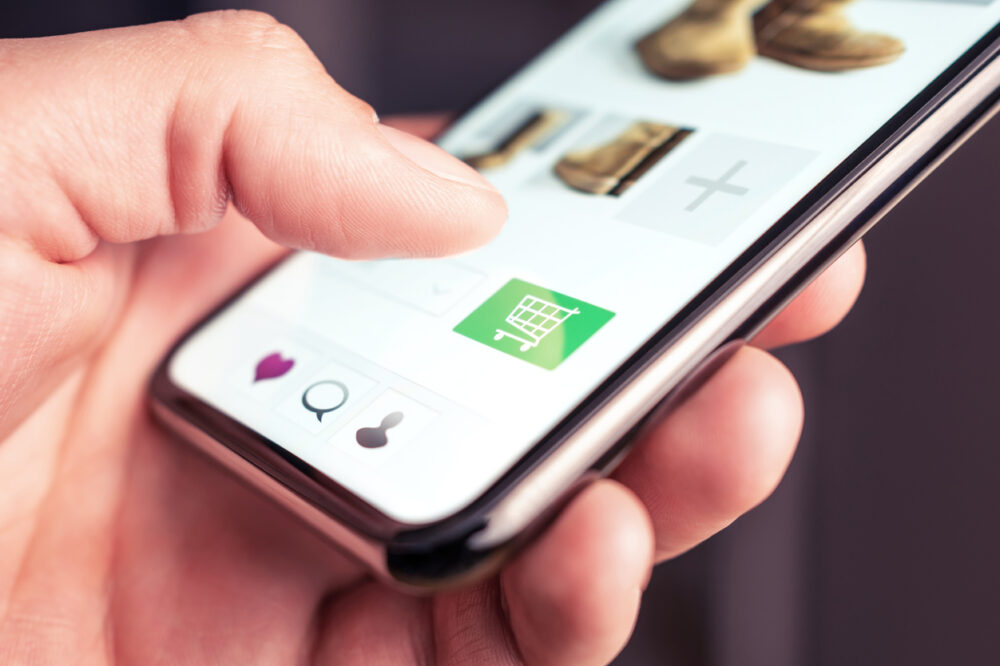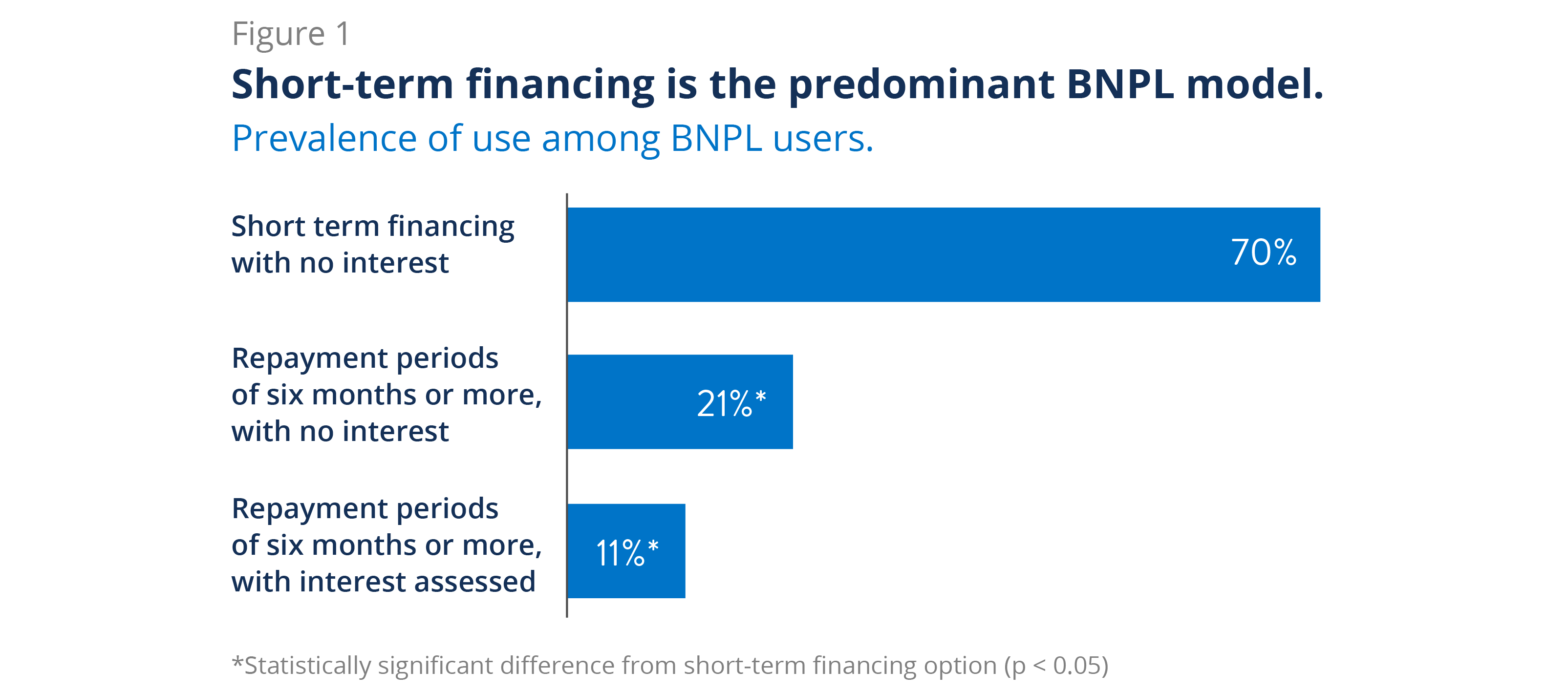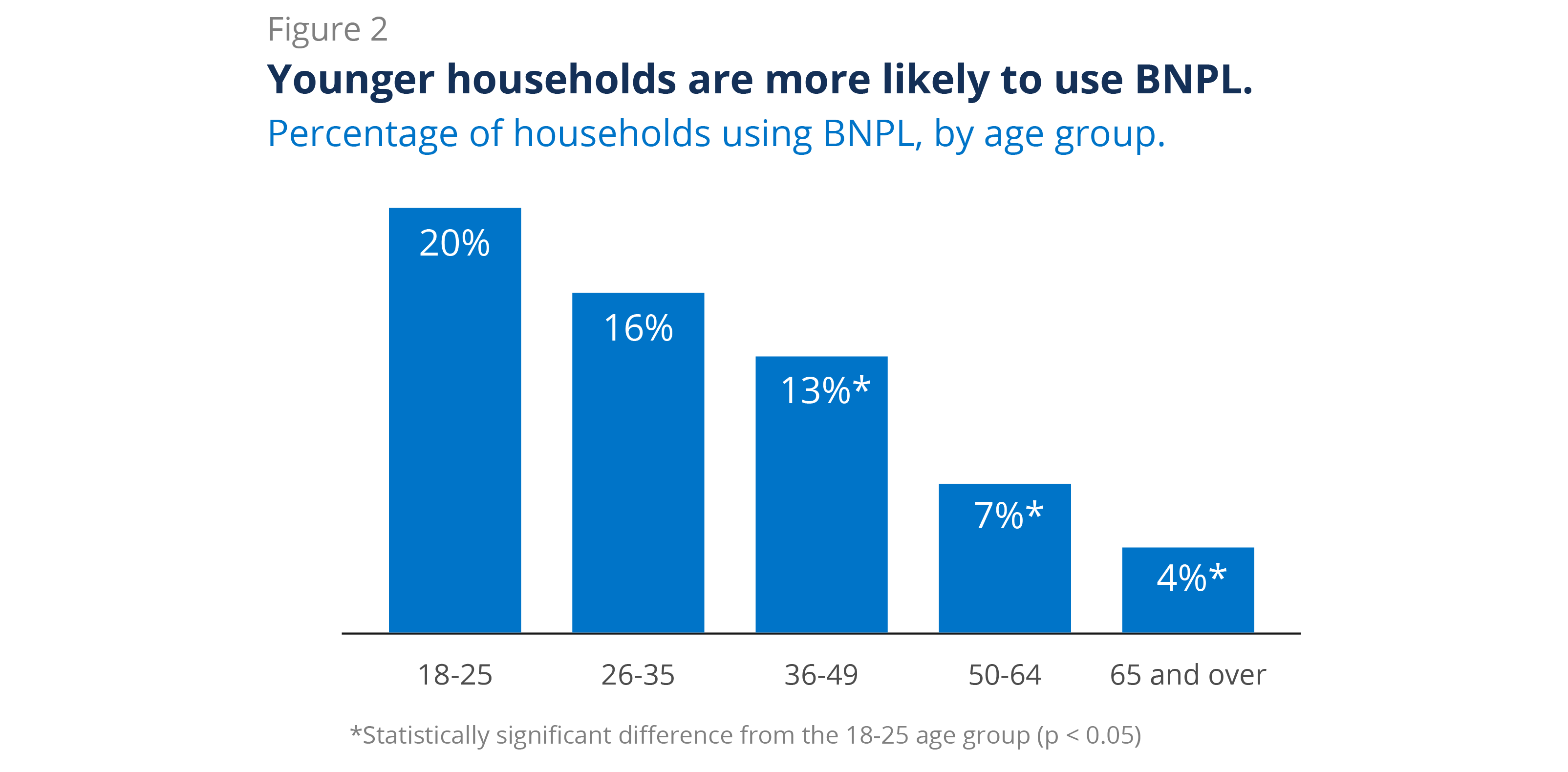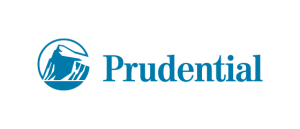Buy Now, Pay Later: Implications for Financial Health
In this brief, we leverage findings from a nationally representative survey to better understand the buy now, pay later (BNPL) market, the users who are driving it, and the implications for their financial health.
-
Program:
-
Category:

- Younger and less financially healthy households are more likely to use BNPL. Financially Vulnerable households are nearly four times more likely to use BNPL than Financially Healthy households (18% vs. 5%).
- Despite the recent emergence of BNPL in the United States, almost half (46%) of users had used BNPL three or more times in the previous 12 months, as of November 2021.
- Nearly one-third (30%) of users spent more than they would have if BNPL hadn’t been available.
- While few users overall (8%) report difficulty making payments, nearly a quarter (24%) of Financially Vulnerable BNPL users report challenges.¹
Understanding Buy Now, Pay Later
Buy now, pay later (BNPL) is a retail payment option that enables consumers to split a purchase into smaller installments, with the first installment typically due at checkout. Shoppers generally are promised no interest or fees – as long as payments are made on time – and they can apply for the loan through a quick online process.
In recent months, BNPL has gained increasing attention among media and policymakers alike, who are interested in understanding the payment trend and its broader implications. In December 2021, the Consumer Financial Protection Bureau (CFPB) opened an inquiry into BNPL, expressing concerns about “accumulating debt, regulatory arbitrage, and data harvesting in a consumer credit market already quickly changing with technology.”² Considering the reported exponential growth in BNPL in recent years, it is all the more important to dig deeper into BNPL and understand its implications on consumer financial health.³
BNPL Is a Modern Twist on Payment Plans
Buy now, pay later offers point-of-sale loans that allow consumers to pay for online or in-store retail purchases over a set period, typically four payments over six weeks. These loans allow consumers to purchase products immediately and pay only a portion of the cost upfront.
Deferring payment is not a new concept; rather, BNPL is an updated approach to payment plans such as layaway, rent-to-own, and other retail installment programs. BNPL loans, however, have gotten a fintech refresh and are typically offered by third-party companies through an online application during checkout.
The BNPL landscape is rapidly changing. Companies offering BNPL services include Affirm, Afterpay, PayPal, Sezzle, Zip, and Klarna; numerous banks, payment processors, and other firms have also entered the game in recent months. During the 2021 holiday season, BNPL was nearly ubiquitous at online retailers.
Though the dominant BNPL product has a pay-in-four model, several providers offer repayment options varying in terms, number of payments, interest, fees, and more. This and BNPL’s semblance to other installment products have made defining and measuring the market particularly challenging.
As part of our 2022 FinHealth Spend Report, which analyzes fees and interest paid by consumers on dozens of everyday financial services, the Financial Health Network fielded a nationally representative survey in November 2021, querying 5,033 households about their use of a wide range of financial services, including BNPL. The FinHealth Spend survey explored three types of BNPL services, which we defined in our questionnaire as follows:
-
- Short-term financing with no interest (these are typically less than six months and often follow the pay-in-four model).
- Financing with repayment periods of six months or more, with no interest.
- Financing with repayment periods of six months or more, with interest assessed.

Our survey found that approximately 10% of households in America used BNPL in the 12 months prior to November 2021.⁴ Of these, the vast majority of BNPL users (70%) used a service that offered short-term financing with no interest (Figure 1). About one-fifth (21%) reported using longer-term, no-interest models, while only 11% said they used a BNPL service that applied interest.⁵
Younger and Less Financially Healthy Households Are More Likely To Use BNPL
Previous research on the growing BNPL market has shown prevalence among younger generations – particularly millennials and Generation Z – who may be looking for a tech-friendly alternative to credit cards.⁶
Indeed, our survey found that 20% of respondents 18-25 reported that they had used a BNPL service in the last 12 months, compared with 16% of respondents 26-35 and only 13% of respondents 36-49 (Figure 2).

Latinx respondents are nearly twice as likely to turn to BNPL than White respondents: 16% of Latinx households report having used BNPL in the 12 months prior to November 2021 – as have 12% of Black households – compared with 9% of White households.
Importantly, our data show that BNPL users are less financially secure than nonusers. Financially Vulnerable households are those who struggle to spend, save, borrow, and plan, according to the FinHealth Score® measurement framework. As opposed to Financially Healthy households, Financially Vulnerable households struggle in almost all areas of their financial lives. Financially Vulnerable households are nearly four times more likely to use BNPL than Financially Healthy households (18% vs. 5%). Additionally, 24% of households that reported using BNPL are considered Financially Vulnerable, compared with 13% of households that don’t use BNPL.
BNPL users are also more likely to struggle with credit. Nearly half of BNPL users (43%) report having subprime credit scores, compared with 24% of nonusers.⁸ Additionally, BNPL users who hold credit cards are more likely to have outstanding credit card debt: 77% of BNPL users who also have credit cards say they have carried a balance on their credit cards over the past year, compared with 49% of nonusers. Interestingly, 23% of BNPL users and a similar percentage of nonusers (26%) do not use a credit card.
Through an analysis of public filings by industry leaders Affirm, Afterpay (acquired by Block, which was formerly known as Square), and Klarna, we estimate that BNPL interest and fees in 2021 totaled less than $1 billion. By comparison, we estimate that households who carry balances on general purpose credit cards paid $95 billion in interest and fees in 2021. In the U.S. in 2021, the gross merchandise volume (GMV) for BNPL was estimated at $55 billion by Mercator Advisory Group, though other volume estimates vary significantly.⁷
Almost Half of BNPL Users Have Made 3 or More Purchases With the Service
Although BNPL services are still considered to be in the early adoption phase in the U.S., evidence suggests that some households are already using them repeatedly. Among those who reported using BNPL within the past 12 months, almost half (46%) reported that they had used the service three or more times in the last year.
Users of the short-term, no-interest model reported owing an average of $330 across all BNPL purchases at the time of the survey. This suggests that users turn to BNPL in this iteration to smooth out the cost of low- to mid-range purchases, rather than to purchase big-ticket items like appliances or furniture. We cannot tell from our data whether BNPL users owe these outstanding balances on one plan or across multiple plans.
Nearly One-Third of BNPL Users Report Increased Spending
No-interest BNPL products offer consumers the benefit of deferring payment on a purchase at no additional cost. This can provide consumers more purchasing power and a convenient short-term repayment mechanism. It could also help them avoid incurring additional revolving credit card debt.

However, if BNPL induces consumers to overspend their budget and take on net additional debt, even at 0% interest, this could have a negative impact on savings, borrowing, and, ultimately, financial health. Among BNPL users in our survey, 30% said they spent more than they would have if BNPL had not been available to them at the time of purchase (Figure 3). Further, when asked what payment method they would have used had BNPL not been available, 34% of BNPL users responded that they would not have made the purchase at all (Figure 4).⁹ Taken together, 47% of users said that the availability of BNPL led them either to make a purchase they otherwise would not have made or to spend more than they would have without BNPL.

This suggests that while in some cases BNPL may act as a stand-in for credit or debit card purchases, in other cases BNPL may have triggered purchases or incremental spending outside consumers’ normal spending patterns.
While Few BNPL Users Have Difficulty Making Payments, Nearly One-Quarter of Financially Vulnerable Users Report Challenges
BNPL can offer a no-cost financing option for consumers who use a no-interest service and make their payments on time. However, for those who don’t understand the terms of the service or cannot afford the payments, BNPL can lead to further financial hardships in the form of late fees, interest charges, or overdraft penalties, to name a few.
Overall, few consumers in our survey reported negative experiences with payments, terms, or fees. Only 8% of BNPL users said either that it was difficult for them to make the payments or that they missed a payment, and just 1% of users reported having trouble understanding the terms and conditions associated with the service.¹⁰
However, difficulties with payments were disproportionately reported by Black BNPL users and households struggling with areas of financial health. Late or missed payments, or difficulty making payments, were more frequently reported among Black households (13%), households with subprime credit (14%), and Financially Vulnerable households (24%).¹¹
BNPL's True Impact Remains To Be Seen
The story these findings tell is still unfolding. For one, BNPL financing could benefit consumers who are looking for tools to help balance their income and expenses. We see minimal evidence at this stage of consumers reporting incurring fees or struggling to meet payments, although challenges rise among the Financially Vulnerable. It’s critical that we carefully monitor user experience with fees and terms as BNPL proliferates.
At the same time, we see a sizable share of consumers reporting spending more than they would have, or making purchases that they otherwise would not have made. BNPL may help users break expenses into more manageable chunks, or it may induce consumers to spend more than they can afford.
We also see early signs of frequent BNPL usage. While it’s possible that a single BNPL transaction may be beneficial or, at worst, neutral from a financial health perspective, multiple overlapping BNPL transactions taken out by the same consumer could amass into a complicated set of payments.¹² Recent developments in the credit bureaus may lead to reporting of BNPL transactions; this in turn would enable BNPL providers to underwrite in ways that help prevent unaffordable usage and potentially allow for credit-building capability.¹³ ¹⁴
While these data are far from conclusive, we hope our findings add to the conversation and lend insight into the key questions around the BNPL market. We encourage others to join us in the effort to better understand and shape this evolving market in the direction of financial health.
Methodology Notes
Data in this brief come from the FinHealth Spend survey, fielded November 1-23, 2021 to USC’s nationally representative Understanding America Study (UAS) panel. The survey asked questions about households’ use of various financial products and services, including BNPL. The panel collected 5,033 responses, which were weighted to reach a nationally representative sample with respect to gender, race/ethnicity, education, age, and census region. Financial health was measured according to the Financial Health Network’s FinHealth Score® methodology.
About the FinHealth Spend Report
The FinHealth Spend Report, previously known as the Financially Underserved Market Size Study, is one of the Financial Health Network’s longest-running research initiatives. The report analyzes household spending on dozens of financial products and services, leveraging extensive secondary research as well as a nationally representative survey on consumer spending. Through this initiative, we gain insight into the impact that interest and fees have on families in the United States and uncover disparities in our system.
The Financial Health Network collaborates with the University of Southern California Dornsife Center for Economic and Social Research to field the FinHealth Spend survey to its online panel, the Understanding America Study.
The FinHealth Spend Report is made possible through the financial support of Prudential Financial.
¹ Throughout this brief, the percentages we compare across different groups of households are statistically significant relative to the reference group, unless stated otherwise. The reference group for BNPL users is the group of households who don’t use BNPL; for Black and Latinx households it is White households; for Financially Vulnerable households it is Financially Healthy households; and for age groups it is 18- to 25-year-old households.
² “Consumer Financial Protection Bureau Opens Inquiry into ‘Buy Now, Pay Later’ Credit,” Consumer Financial Protection Bureau, December 2021.
³ “The Economic Impact Of Buy Now, Pay Later In The US,” Accenture & Afterpay, September 2021.
⁴ This estimate is considerably lower than many previous estimates, which have found that up to half of U.S. households have used such services. We believe, however, that our finding is consistent with published reports from leading providers regarding the number of active users. The difference between our finding and others may rest in differences in survey methodology. Our survey was administered to the University of Southern California (USC) Understanding America Study (UAS) panel, a nationally representative, probability-based internet panel constructed via address-based sampling. For additional information, see methodology notes.
⁵ Survey respondents were able to select multiple answers to the question “You indicated you have made an online or mobile purchase from a retailer using a service that allows you to pay in installments (also known as buy-now-pay-later). Which of the following have you utilized?” Therefore, response categories are not mutually exclusive, though few users indicated using multiple types.
⁶ Samantha Subin, “Why millennials and gen-Zs are jumping on the buy now, pay later trend,” CNBC, August 2021.
⁷ Brian Riley, “Buy Now, Pay Later: Gaining Scale and the Disrupting Status Quo in Lending,” Mercator Advisory Group, May 2021.
⁸ Credit tiers are self-reported and determined based on survey responses to the question “How would you rate your credit score?” Responses of “Fair,” “Poor,” “I don’t have a credit score,” and “Don’t know” are assigned to subprime. The subprime credit category therefore captures those who reported that they don’t have a credit score and who don’t know their credit scores.
⁹ This is even more pronounced when examined by financial health: 61% of Financially Vulnerable households who used BNPL reported that they would not have made the purchase, compared with only 7% of Financially Healthy households.
¹⁰ Our finding with respect to the percentage of BNPL users who report missing a payment is materially lower than findings in other surveys, which have found rates above 30%. Methodological differences discussed in Footnote 4 may explain the discrepancy.
¹¹ This analysis included BNPL users who answered yes to either of the following statements: “It was difficult for me to make the payments” (4% of BNPL users overall responded yes to this statement) and “I was late or missed one or more payments” (4% of BNPL users overall responded yes to this statement).
¹² Current BNPL underwriting does not involve a hard credit inquiry, so providers cannot see whether a consumer is overextended.
¹³ “Equifax First to Formalize Inclusion of ‘Buy Now, Pay Later’ Payment Information in Consumer Credit Reports,” Equifax, December 2021.
¹⁴ “Experian Launches World’s First BNPL Bureau,” PYMNTS.com, January 2022.
Written by
Buy Now, Pay Later: Implications for Financial Health
Explore the trends. Discover new insights. Build stronger strategies.



